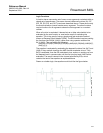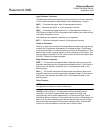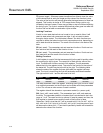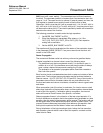
Reference Manual
00809-0100-4696, Rev AA
September 2004
3-19
Rosemount 848L
SHR (input, shift, reset, testbit) - The parameters input, shift and reset are
functions. The parameter testbit is a constant that is constrained to be in the
range of 1 to 8. The reset function is optional. If reset is present and true, the
8 bit register is cleared to zero and the result of the function is false.
Otherwise, if shift is true then bit 2 will be moved to bit 1, bit 3 to bit 2, bit 4 to
bit 3, bit 5 to bit 4, bit 6 to bit 5, bit 7 to bit 6, bit 8 to bit 7, and the value of input
will become the value of bit 8. Then the bit specified by testbit will be tested to
determine the value of the function.
The following procedure is used to enter the logic equations.
1. Set MODE_BLK.TARGET to OOS
2. Enter the equations in parameters EQn where n=1 to 16 or
OUT1_EQ, OUT2_EQ, OUT3_EQ or OUT4_EQ. Each equation
ending with a semicolon.
3. Set the MODE_BLK.TARGET to AUTO
The equations will then be evaluated and the status of the evaluation shown
in the parameter PARSE_RESULT. If any errors were found the block will
remain in the OOS mode.
Status Propagation
The contact and Boolean value has a binary value and a good/bad status.
A status is applied to a channel value in one of the following ways:
The hardware input device maybe able to tell if it is shorted or open, in
addition to on or off. If the hardware cannot tell then the status is always
good, unless a device failure prevents reading the I/O data.
The evaluation of an equation propagates either Good Non-cascade or
Bad, both Non-specific.
Each function that is evaluated determines both a value and a status of either
good or bad. The functions that provide status are the functions that test a
channel number - IN, ICF, ICR, OUT, DO, PS and EQ. If any of the function’s
parameters have a Bad or Uncertain status with any sub-status then the
function terminates and returns a bad status, otherwise it returns a good value
and status.
When an equation (set of functions) is evaluated, if a function returns a bad
status then evaluation of that equation stops, and the equation channel status
is set to Bad, Non-specific. If evaluation goes to completion, the channel
status will be set to Good Process, Non-specific, not limited.
Status propagates forward, in the direction of the last output equation. If a
function references an equation that is the equation being evaluated or a later
equation, then the status of that equation will be ignored. The function will use
the last good value of the referenced equation and call its status Good. This
prevents forward references to equations that reference this equation from
locking both equations into Bad status if either ever sets Bad status.
During initialization of the logic transducer block, before the first execution,
each equation channel status is set to Bad, Non-specific, constant and the
value is set to False.


















